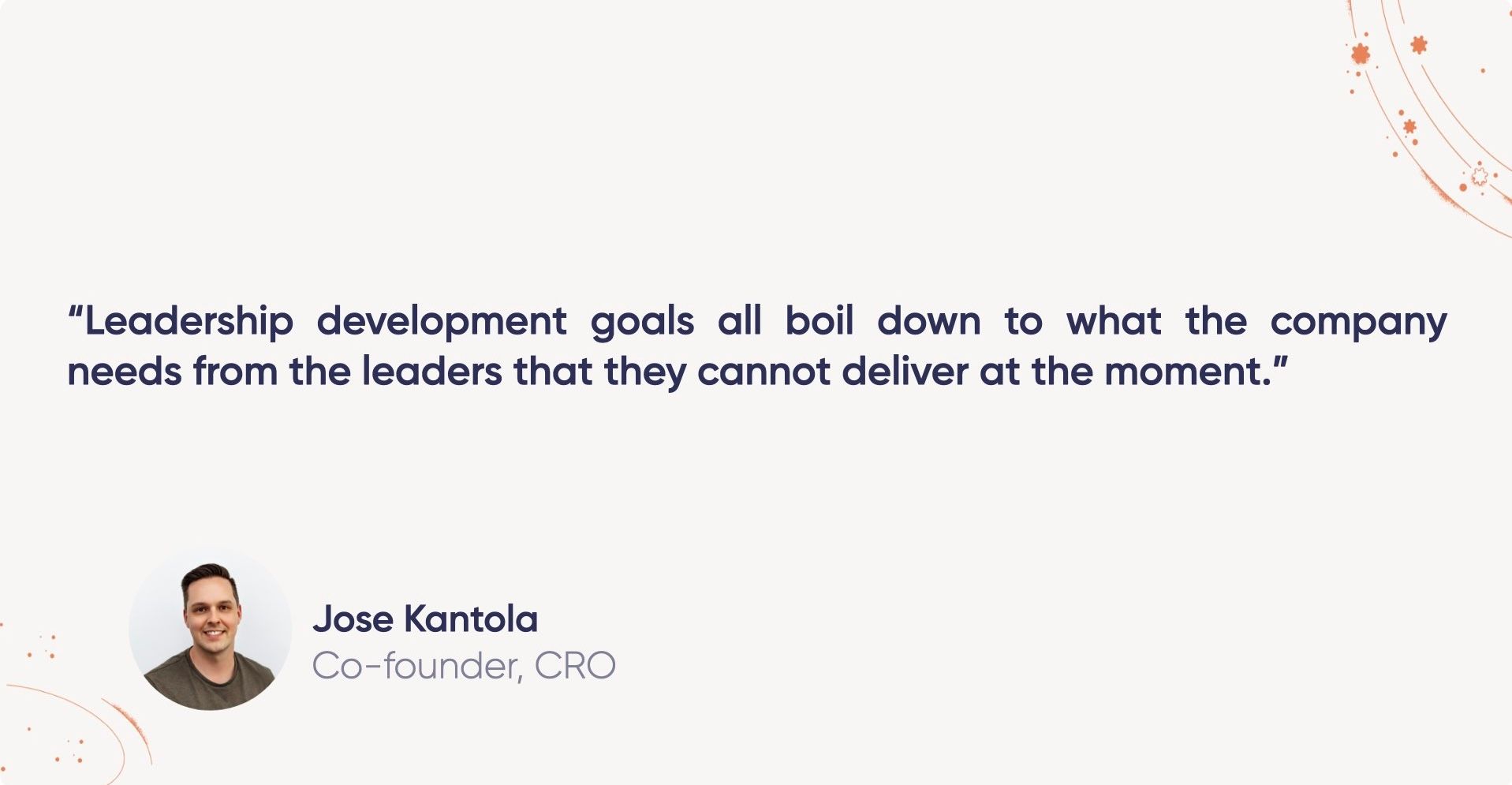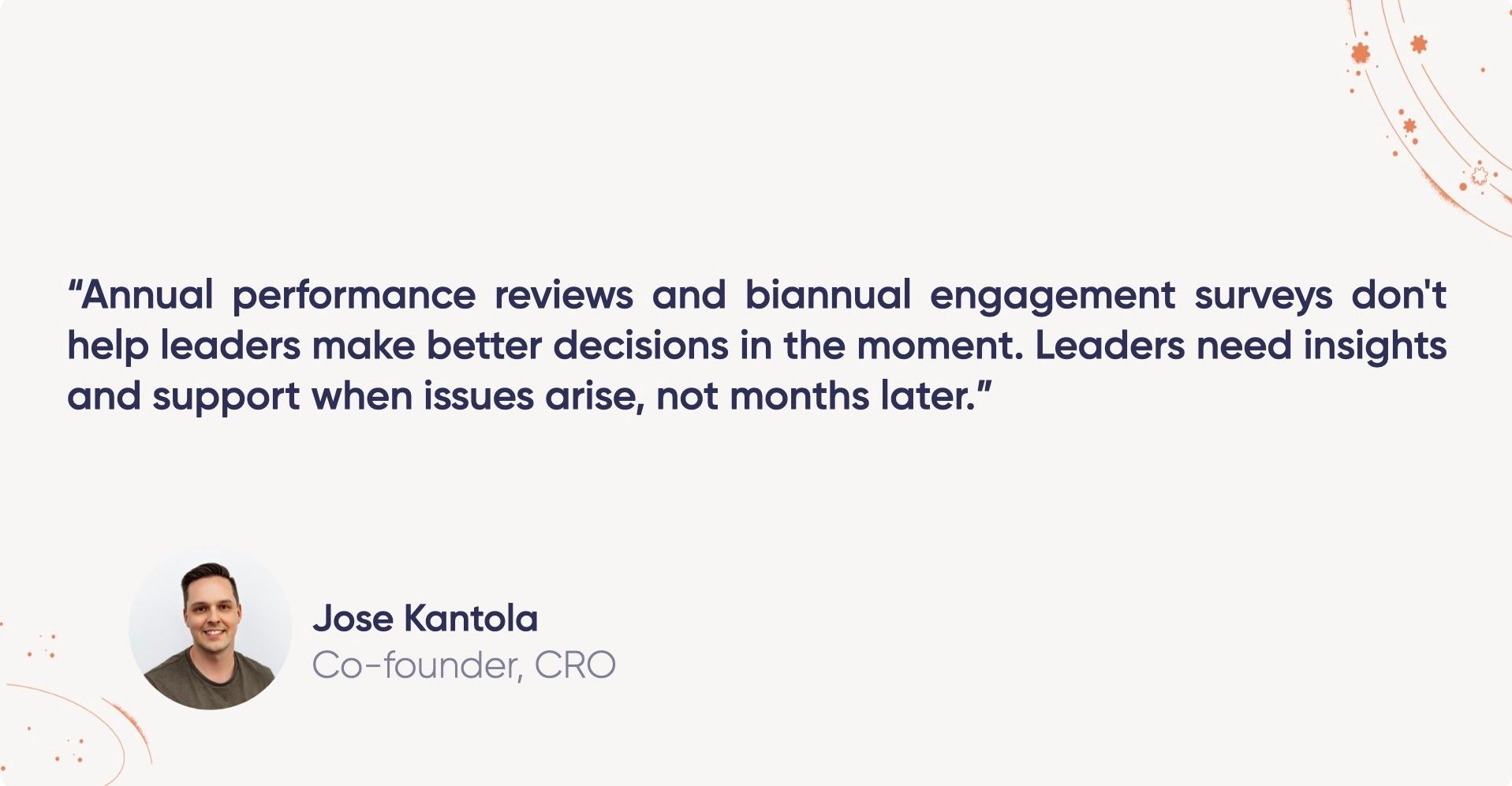Leadership Development Program: Traditional vs Modern Approaches
November 20, 2025Explore what leadership development programs are, their goals, and why modern enablement tools provide more personalized, real-time support than traditional programs.
I'll never forget the leadership development program I attended early in my career. Two full days offsite, motivational speakers, team-building exercises, and a binder full of frameworks I never opened again.
Three months later, I faced a real leadership challenge: a team member consistently missing deadlines. I had no idea how to handle it. The program hadn't prepared me for this specific situation.
Over the years, I've worked with dozens of companies growing their leadership teams. I've seen some leadership development programs that deliver real value. But I've also watched organizations invest hundreds of thousands to produce minimal impact.
The landscape is changing. Traditional leadership development programs are being challenged by modern enablement tools that provide personalized, real-time support. In this article, I will walk you through what leadership development programs are, their key goals, and how modern software is reshaping how companies approach leadership development initiatives.
What Is a Leadership Development Program?
A leadership development program is a structured initiative designed to build leadership capabilities across an organization.
These programs typically include:
- Workshops or training sessions on leadership topics
- Cohort-based learning with other leaders
- Assessments to identify strengths and development areas
- Action learning projects or assignments
- Coaching or mentorship components
Programs can last anywhere from a few days to several months. They're usually designed for specific leadership levels: new managers, mid-level leaders, or senior executives.
But here's what I've observed: the format assumes all participants need roughly the same development at the same time. This works well in some situations. In others, it misses the mark completely.
Tired of static L&D programs?
Enable your leaders with the right tools with Teamspective. See the benefits of leadership enablement today.
Schedule DemoKey Goals of a Leadership Development Program
Every leadership development program aims to achieve specific outcomes. Based on my experience, here are the most common goals:
Building Core Leadership Skills
Programs focus on teaching fundamental capabilities like:
- Communication and feedback
- Performance management
- Delegation and empowerment
- Strategic thinking
- Change management
These skills form the foundation of effective leadership. Without them, leaders struggle regardless of their technical expertise.
Creating a Common Leadership Language
When leaders go through programs together, they develop shared frameworks and vocabulary.
This alignment helps the organization function more smoothly. Leaders can reference the same models and approaches when making decisions or solving problems.
Preparing Leaders for Increased Responsibility
Many programs target leaders who are about to take on bigger roles. The goal is to build capabilities before they're needed.
For example, a program for new directors might focus on strategic thinking and executive presence, skills they'll need as they move from managing teams to leading functions.
Building Networks Across the Organization
Cohort-based programs bring together leaders from different departments or locations.
These connections break down silos. Leaders who know each other personally are more likely to collaborate effectively across boundaries.
Driving Cultural Change
Organizations often use leadership programs to reinforce cultural values or shift leadership behaviors.
If a company wants to move from a command-and-control culture to a coaching culture, a leadership program can teach and model the new approach.
Improving Organizational Performance
Ultimately, every leadership program aims to improve business results through better leadership.
This might mean higher employee engagement, better retention, faster execution, or improved collaboration. The specific outcomes depend on what the organization needs.

Traditional Leadership Development Programs vs Modern Leadership Enablement Tools
This is where things get interesting. Traditional programs have been the standard for decades. But modern tools are challenging that model in important ways.
Let me break down the key differences.
One-Size-Fits-All vs Personalized Approach
Traditional programs assume participants are in similar situations and need the same development.
You might have 20 leaders in a room learning about performance management. But their actual challenges are completely different:
- One leader manages a high-performing team and needs help with succession planning
- Another struggles with an underperforming team member
- A third faces collaboration issues with other departments
The program treats them all the same. Some content will be relevant. Much of it won't be.
Modern enablement tools take a different approach. Platforms like Teamspective analyze each leader's specific situation: their team's engagement data, performance metrics, collaboration patterns.
Then they provide personalized guidance based on what that leader actually needs right now. If your team's engagement just dropped, you get insights about why and what to do. If performance is the issue, the guidance shifts accordingly.
This personalization makes development dramatically more relevant and impactful.
Timing: Scheduled vs On-Demand
Traditional programs happen on a schedule. You attend a workshop in Q2, whether or not you're facing leadership challenges that moment.
Then in Q4, when you actually need help with a difficult performance conversation, the workshop content is months old. You don't remember the details. The moment passes.
Modern tools provide support when leaders need it. When engagement data reveals an issue, the leader gets guidance immediately. They can act while the problem is still small and fresh.
This timing difference is huge. Real-time support allows leaders to address issues before they escalate. Scheduled programs often come too late or too early to be useful.
Time Investment: Days vs Minutes
Traditional programs require a significant time commitment. A two-day offsite means two days away from your team and responsibilities.
For 20 leaders, that's 40 days of productivity lost. Plus travel time, preparation, and follow-up work.
Modern tools integrate into leaders' existing workflows. A leader might spend 5 minutes reviewing their team's latest engagement data and 10 minutes in their next one-on-one applying the insights.
The development happens continuously in small increments, not in intensive bursts that pull leaders away from their work.
Relevance: Generic Best Practices vs Specific Guidance
Traditional programs teach general principles and frameworks. These can be valuable. But they require leaders to figure out how to apply them to their specific situations.
"Here's a model for giving feedback. Now go figure out how to use it with your team."
The translation from principle to practice is left to the leader. Some do this well. Many don't.
Modern tools provide specific, actionable guidance. Not "here's a feedback model" but "your team's clarity on priorities declined this week. Here are three questions to ask in your next team meeting to address it."
The gap between learning and action shrinks dramatically.
Measuring Impact: Assumptions vs Data
Traditional programs often measure success through participant feedback. "Did you like the program? Would you recommend it?"
But positive feedback doesn't mean leadership improved or business results changed.

Modern tools track actual outcomes. Did engagement scores improve after the leader acted on the guidance? Did performance ratings change? Did collaboration increase?
This data-driven approach makes it clear what's working and what isn't.
Which Should You Choose?
The honest answer is it depends on what you're trying to achieve.
Traditional programs work well when:
- You need to establish baseline leadership capabilities across many leaders
- Building networks and relationships is a priority
- You're driving significant cultural change
- You have cohorts of leaders in genuinely similar situations
Modern tools excel when:
- Leaders face diverse, situation-specific challenges
- You need to provide support continuously, not periodically
- Relevance and immediate application matter most
- You want to measure the actual impact on team outcomes
- Resources are limited and need to be deployed efficiently
In my experience, the best approach often combines both. Use programs for foundational development and cultural alignment. Use tools for ongoing, personalized support.
But if I had to choose one? I'd choose the tool. Because relevance and timing determine whether leadership development actually changes behavior. And modern tools win on both fronts.

Future Trends for Leadership Development
The leadership challenges organizations face are evolving. Leadership development needs to evolve with them.
Based on what I'm seeing across companies, here's where things are headed.
Increased Focus on Performance
The pressure to maintain profitability isn't going away. If anything, it's intensifying.
This means leadership development will focus more on capabilities that directly drive performance:
- Making faster, better decisions based on data
- Having difficult conversations about performance issues
- Setting clear expectations and holding people accountable
- Removing obstacles that slow teams down
The days of purely inspirational leadership programs are fading. Development needs to help leaders deliver results.
Prioritizing Collaboration Skills
As organizations grow, collaboration becomes harder and more critical.
I'm seeing this pattern everywhere: employee engagement surveys consistently reveal collaboration as a major pain point. Teams work in silos. Information doesn't flow. Cross-functional projects get stuck.
Future leadership development will emphasize:
- Building relationships across organizational boundaries
- Breaking down silos between teams
- Navigating competing priorities and conflicts
- Creating conditions for effective teamwork
Leaders who can drive performance while building collaboration will be the most valuable.
Shift to Continuous, Real-Time Development
The annual or quarterly program model is dying.
Leaders need support when they face challenges, not months later. Technology makes continuous development possible at scale.
Expect to see more:
- Just-in-time coaching and guidance
- Micro-learning integrated into daily work
- Real-time feedback and insights
- AI-powered personalization
Development becomes less like attending school and more like having a coach in your pocket.

Data-Driven Approaches
Leadership development is moving from intuition-based to evidence-based.
Instead of assuming what leaders need, organizations will use data to:
- Identify specific development needs for each leader
- Prioritize the highest-impact development areas
- Track whether development actually improves outcomes
- Adjust approaches based on what works
This makes development more efficient and more accountable.
Integration with Company Values and Leadership Principles
Generic leadership content is losing ground to content aligned with organizational culture.
Future development tools will incorporate company-specific values and leadership principles. Every recommendation, every coaching point will reinforce how your organization believes leaders should behave.
This creates consistency across leaders while still personalizing to individual needs.
Emphasis on Enablement Over Programs
The fundamental shift is from pushing leaders through programs to enabling leaders to get what they need, when they need it.
Ownership shifts to the leader. Development becomes something leaders actively use to solve problems, not something done to them on a schedule.
This requires different technology, different mindsets, and different measures of success. But it produces leaders who are more capable and more engaged with their own development.
Conclusion
I've participated in and observed dozens of leadership development programs over my career. The best ones created real value. But even the best had limitations.
They couldn't be relevant to every participant. They couldn't provide support when leaders actually faced challenges. They couldn't easily adapt as situations changed.
Modern leadership enablement tools solve these problems. They provide personalized, real-time support that helps leaders address their specific challenges immediately. This doesn't mean traditional programs have no place. They're still valuable for foundational development, cultural alignment, and building networks.
But the future of leadership development is personalized, continuous, and data-driven. It's about enabling leaders to get the support they need, exactly when they need it.
Ready to move beyond traditional programs to continuous leadership enablement? Book a demo today and see how Teamspective transforms leadership development from periodic programs to continuous enablement.



